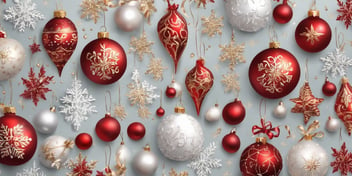- Blog
- Christmas tree
- From Candles to Baubles: Christmas Tree Traditions Around the World

As the chilly winter winds begin to sweep through our streets and the aroma of freshly baked cookies fills the air, it can only mean one thing - Christmas is right around the corner. While we eagerly await the arrival of Santa Claus, we also eagerly prepare our homes for the festive season. Perhaps one of the most iconic symbols of Christmas is the evergreen tree, adorned with twinkling lights and an array of ornaments.
But, have you ever wondered how this beloved tradition came to be? Join us on a global journey as we explore the captivating and diverse Christmas tree traditions from around the world, unraveled from the flickering glow of candles to the dazzling baubles adorning our trees today.
Exploring the Global Diversity of Christmas Tree Traditions
Exploring the global diversity of Christmas tree traditions reveals a rich tapestry of cultural practices. Different countries and regions have unique ways of celebrating with festive evergreens.
For example, in Germany, Christmas trees have been a cherished tradition since the 16th century, with ornaments like gingerbread cookies and handmade figurines adorning the branches. In Brazil, where Christmas falls during the summer, it is common to decorate palm trees with colorful lights and ribbons. These diverse traditions highlight the beauty of cultural exchange and offer inspiration for creating your own unique Christmas tree traditions.
The Origins of the Christmas Tree
Uncovering the Ancient Roots of Decorating Evergreens
Throughout history, decorating evergreen trees has been a significant part of various cultures' winter celebrations. Ancient civilizations, such as the Egyptians, Romans, and Vikings, adorned evergreens with ornaments and garlands as symbols of life and rebirth during the winter solstice. This tradition has evolved over time and has been incorporated into modern-day Christmas tree customs around the world.
For example, in Germany, the use of candles and handmade decorations on the Christmas tree dates back to the 16th century. Exploring these ancient roots offers us a deeper understanding of the rich cultural heritage and global diversity of Christmas tree traditions.
The Pagan Symbolism and Winter Solstice Connections
The pagan symbolism and winter solstice connections have greatly influenced the Christmas tree traditions observed around the world. In ancient times, evergreens were seen as symbols of fertility and renewal during the winter season. The practice of decorating trees with lights and ornaments can be traced back to these pagan rituals.
For example, the use of candles on Christmas trees symbolized the return of light during the darkest days of winter. Today, many cultures continue to incorporate elements related to these ancient traditions when decorating their Christmas trees.
Adoption by Early Christians and Religious Significance
Early Christians adopted the tradition of decorating evergreen trees, infusing them with religious significance. These trees were seen as symbols of everlasting life and hope, reflecting the belief in Jesus Christ's birth and promise of salvation. Over time, various decorations and symbols were added to the trees, such as candles representing Christ as the light of the world.
Today, this tradition continues to be observed worldwide, with Christians incorporating religious ornaments, like crosses or angels, into their Christmas tree decorations. This practice serves as a meaningful reminder of the religious roots of Christmas and the importance of faith during the festive season.
Christmas Tree Traditions Around the World
Christmas Tree Traditions Around the World: A Global Overview
- Varieties of Christmas tree traditions can be found across the globe, reflecting the diverse cultures and customs of different countries.
- In Germany, the tradition of decorating Christmas trees dates back to the 16th century and has influenced modern practices worldwide.
- Norwegian households often opt for a majestic spruce tree as a national symbol of Christmas.
- American traditions involve elaborate lighting displays and the use of tinsel to create shimmering trees.
- Brazilian celebrations embrace the tropical setting by decorating trees on the beach.
- Japanese households have adopted the trend of "Christmas Cake Trees," where edible ornaments replace traditional decorations.
- Indian traditions fuse Western and traditional Indian elements, resulting in unique and colorful tree decorations.
These global Christmas tree traditions showcase the creativity and ingenuity of different cultures, making the holiday season even more special and meaningful for people worldwide.
Europe
German Christmas Tree Traditions
German Christmas tree traditions have had a significant impact on the way we decorate evergreens during the holiday season. Dating back to the 16th century, Germans were among the first to bring trees indoors and adorn them with candles, sweets, and gingerbread. Today, their tradition of using real candles on the tree continues, albeit with extra safety precautions.
Additionally, German households often place a small nativity scene under the tree, emphasizing the Christian roots of Christmas. The influence of German customs can be seen worldwide, with many countries adopting similar practices in their own Christmas celebrations.
The Influence of Germany on Modern Christmas Trees
German Christmas tree traditions have had a significant impact on the modern concept of decorating Christmas trees worldwide. The practice of adorning trees with lit candles, glass baubles, and intricate ornaments originated in Germany during the 17th century. These traditions were popularized through German Christmas markets, where beautifully decorated trees became a centerpiece.
Today, many countries have adopted these German customs, incorporating similar elements into their own Christmas tree traditions. The influence of Germany can be seen in the widespread use of ornaments, tinsel, and lights on Christmas trees around the world, adding a touch of German heritage to festive celebrations globally.
Norwegian Christmas Tree Traditions
- Norwegians have a deep-rooted connection with their national tree, the majestic spruce.
- The tradition of decorating Christmas trees in Norway dates back to the 1800s.
- Norwegian Christmas trees are usually adorned with handmade paper baskets filled with treats, heart-shaped ornaments, and small Norwegian flags.
- Candles were traditionally used to light up the tree, but nowadays electric lights are more common for safety reasons.
- The lighting of the tree is often accompanied by the singing of traditional Norwegian carols.
- In some regions of Norway, the Christmas tree is kept until January 13th, known as "Knuts Day," when it is finally taken down.
The Magnificent Norwegian Spruce as a National Symbol
The Magnificent Norwegian Spruce holds immense significance as a national symbol in Norway's Christmas tree traditions.
- The Norwegian Spruce, native to the country's forests, is carefully selected and brought into homes during the holiday season.
- Its majestic appearance and rich green color symbolize the beauty of nature and the spirit of Christmas.
- Norwegians have a tradition of decorating the tree with handmade ornaments, often crafted from natural materials like pinecones and straw.
- The lighting of the Norwegian Christmas tree in Trafalgar Square, London, also showcases the tree's symbolic importance on an international stage.
The use of the Norwegian Spruce as a national symbol demonstrates the deep connection between nature, tradition, and the celebration of Christmas in Norway.
North America
American Christmas Tree Traditions
In American Christmas tree traditions, the use of tinsel and electric lights holds a special place. Tinsel, a shimmering decoration made from thin, metallic strips, adds a touch of sparkle to the tree. Electric lights, with their twinkling glow, create a mesmerizing effect. These adornments have become synonymous with holiday cheer in the United States. Many families enjoy the tradition of carefully draping the tree with tinsel and strategically placing colorful electric lights.
The combinationof tinsel and electric lights adds a magical ambiance to American homes during the festive season.
The Twinkling Wonders of Tinsel and Electric Lights
The use of tinsel and electric lights on Christmas trees adds a magical sparkle to the holiday season. Tinsel, with its shimmering strands, reflects the glow of the lights, creating a mesmerizing effect. The soft twinkle of electric lights brings warmth and joy to the surroundings. This tradition is popular worldwide, as it enhances the visual appeal of the tree and creates a festive ambiance.
Whether it's a simple string of colored lights or an elaborate display of twinkling patterns, the combination of tinsel and electric lights transforms the Christmas tree into a captivating centerpiece of celebration.
Canadian Christmas Tree Traditions
--Canadian Christmas Tree Traditions--
- Canada's Christmas tree traditions are deeply rooted in nature and national pride.
- The country boasts a majestic national Christmas tree that stands on Parliament Hill in Ottawa.
- Canadians often opt for natural trees, showcasing the beauty of locally grown evergreens.
- Many families enjoy visiting tree farms to select and cut down their own tree, making it a cherished annual tradition.
- Canadians embrace the spirit of giving by participating in tree donation programs, providing trees to families in need.
- The use of traditional ornaments, such as handmade decorations and garlands, adds a touch of nostalgia and personalization to Canadian Christmas trees.
The Stunning Beauty of Canada's National Christmas Tree
The Canadian National Christmas Tree showcases the stunning beauty of Canada's holiday traditions. This iconic tree, typically located in Ottawa, captivates locals and tourists alike with its grandeur and festive charm. Adorned with twinkling lights, ornaments, and symbolic decorations representing Canadian heritage, the tree serves as a symbol of national unity and festive spirit.
The breathtaking sight of the National Christmas Tree is a reminder of the joy and pride Canadians take in their holiday celebrations. It inspires communities across the country to decorate their own trees with creativity and enthusiasm, enhancing the festive atmosphere during the holiday season.
South America
Brazilian Christmas Tree Traditions
In Brazil, Christmas tree traditions are uniquely celebrated in a tropical setting. Brazilians often decorate their trees with bright and colorful ornaments to reflect the vibrant spirit of the season. Along with traditional decorations like lights and baubles, it is common to find handmade crafts, ribbons, and even seashells adorning the trees. Many families also incorporate nativity scenes under the tree, emphasizing the religious aspect of Christmas.
Looking beyond the traditional evergreen,some Brazilians even decorate palm trees or create "tree-shaped" structures on the beach. These creative adaptations reflect the country's festive traditions while embracing the beauty of their natural surroundings.
Decorating Trees on the Beach in a Tropical Christmas
- In countries like Brazil, celebrating Christmas takes on a unique twist due to the warm climate and beautiful beaches.
- Instead of traditional evergreen trees, festive palm trees or even artificial trees made of driftwood may take center stage.
- People adorn these beach-themed trees with colorful seashells, starfish, and tropical fruits for a vibrant and coastal aesthetic.
- Coordinating the tree decor with sun, sand, and ocean motifs creates a delightful and refreshing ambiance.
- Embracing the local environment and incorporating beach elements into Christmas tree decorations adds a touch of tropical flair to the holiday season.
Argentinian Christmas Tree Traditions
Argentinian Christmas tree traditions showcase a vibrant mix of local elements and festive decorations. Many Argentinians opt for artificial trees adorned with colorful ribbons, lights, and ornaments. One unique tradition is the use of "globos," which are small paper lanterns shaped like balloons and illuminated from within. These globos add a whimsical touch to the tree and create a magical atmosphere.
Additionally, it is common to incorporate nativity scenes or figures of Santa Claus beneath the tree. Argentinians also embrace the tradition of exchanging gifts on Christmas Eve, placing them under the tree to be opened later.
Incorporating Local Elements into Festive Tree Decor
- Embrace the unique cultural traditions of your region by incorporating local elements into your Christmas tree decorations.
- Use ornaments and decorations that reflect the local heritage, such as miniature replicas of traditional buildings or landmarks.
- Incorporate local flora into your tree decor, such as pinecones, dried flowers, or herbs.
- Consider using handmade ornaments crafted by local artisans, showcasing their traditional craftsmanship.
- Learn about the symbolic colors and motifs of your culture and incorporate them into your tree design.
- Look for inspiration from local festivals, folklore, or traditional costumes when selecting your tree decorations.
- By incorporating local elements, you can create a Christmas tree that truly represents the rich cultural heritage of your region.
Asia
Japanese Christmas Tree Traditions
In Japanese Christmas tree traditions, a modern trend has emerged called "Christmas Cake Trees." These unique trees mimic the appearance of beautifully decorated Christmas cakes. They are typically smaller in size and adorned with colorful ornaments, ribbons, and even small cakes as decorations. The idea behind Christmas Cake Trees is to combine the joy of Christmas with the Japanese love for intricate cake designs.
Families and individuals enjoy creating these edible-inspired trees as a fun and creative way to celebrate the holiday season. This unique twist on traditional Christmas trees showcases the cultural fusion of Japan's culinary artistry and festive traditions.
The Modern Fashion of 'Christmas Cake Trees'
In Japan, a unique Christmas tree tradition has emerged, known as "Christmas Cake Trees." Instead of the traditional evergreen tree, the focus is on a stack of Christmas cakes with colorful decorations resembling a festive tree. These cake trees have gained popularity due to their visual appeal and deliciousness. Families often gather around the cake tree to celebrate Christmas and enjoy slices of cake together.
This modern twist on the traditional Christmas tree reflects Japan's love for both aesthetics and culinary delights, making it a delightful and mouthwatering addition to Christmas celebrations in the country.
Indian Christmas Tree Traditions
- India, a country known for its rich cultural heritage, celebrates Christmas with its own unique touch.
- Indian Christmas trees often incorporate local elements, such as mango leaves, marigold flowers, and banana trees, alongside traditional ornaments and lights.
- In some regions, coconut shells and shells from the ocean are used as decorations, adding a distinct coastal vibe to the festivities.
- Many Indian families also create Rangoli designs around their Christmas trees, using vibrant colored powders or flowers to make beautiful patterns on the floor.
- Indian Christmas tree traditions blend western influences with traditional Indian customs, resulting in a delightful fusion of styles that truly reflects the diverse and vibrant culture of the country.
Joyful Fusion of Traditional Indian and Western Decorations
Indian Christmas tree traditions combine the vibrant colors and rich cultural symbols of India with Western Christmas decorations. The fusion of these two styles creates a unique and joyful display. Many Indian households adorn their trees with traditional ornaments like diyas (clay lamps) and rangoli designs, along with Western elements such as tinsel and fairy lights. This blending of Indian and Western aesthetics allows for a celebration that honors both Christmas and Indian culture.
Families come together to decorate the tree, sharing laughter and creating cherished memories. The joyful fusion of traditional Indian and Western decorations adds a touch of diversity and cultural richness to the global tapestry of Christmas tree traditions.
Final thoughts
Christmas tree traditions vary around the world, with each country putting its unique spin on this beloved holiday symbol. In Germany, the birthplace of the Christmas tree tradition in the 16th century, people still decorate their trees with real candles, while Americans prefer electric lights. In Mexico, trees are adorned with colorful paper ornaments and surrounded by poinsettias. Japan goes for a more minimalist approach, often featuring small, tabletop trees called "mini-no-ki.
" From Ukraine's spider web decorations to Iceland's "Yule Lads" hiding in the branches, these diverse traditions collectively showcase the global importance of the Christmas tree as a center of holiday cheer.
Read On

Uncovering the Fascinating History behind Christmas Tree Traditions
Every year, as the wintery air grows colder and cheerful decorations sparkle in every corner,...

What is the significance of the Christmas tree?
As the holiday season approaches, the sight of a majestic evergreen adorned with sparkling lights...

Exploring Christmas Tree Traditions Around the World
'Tis the season to be jolly and deck the halls with boughs of holly! As the snowflakes dance and...